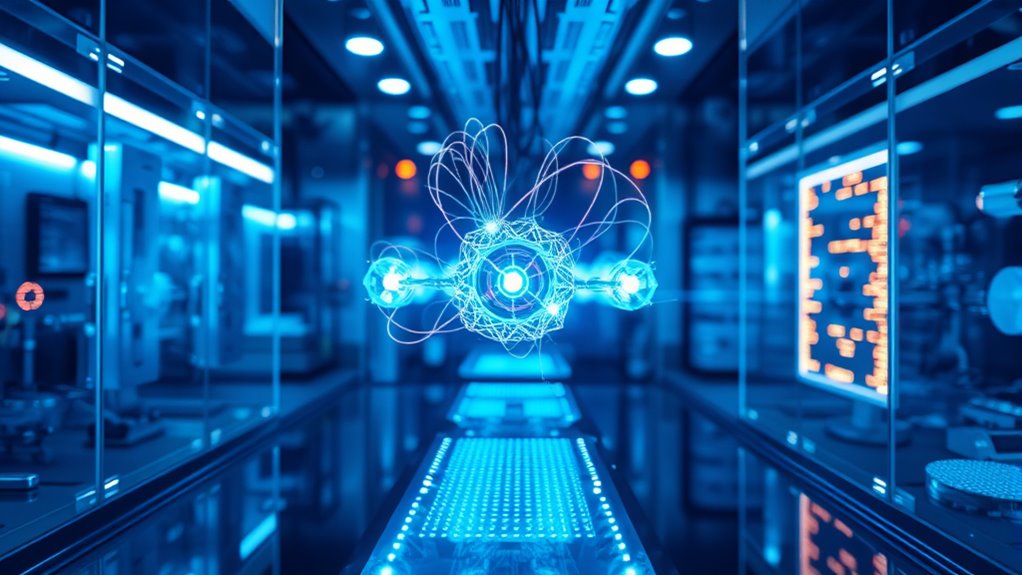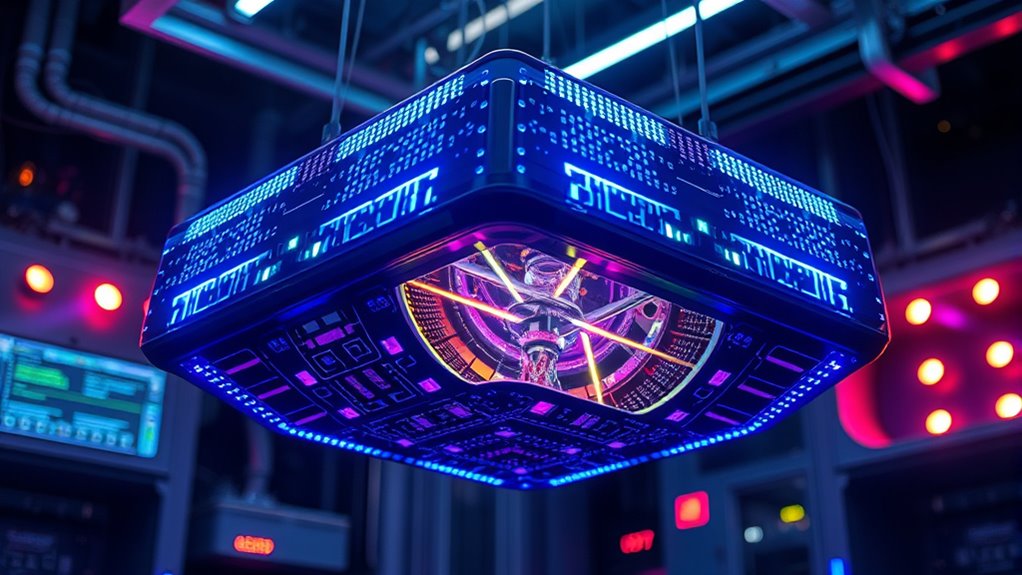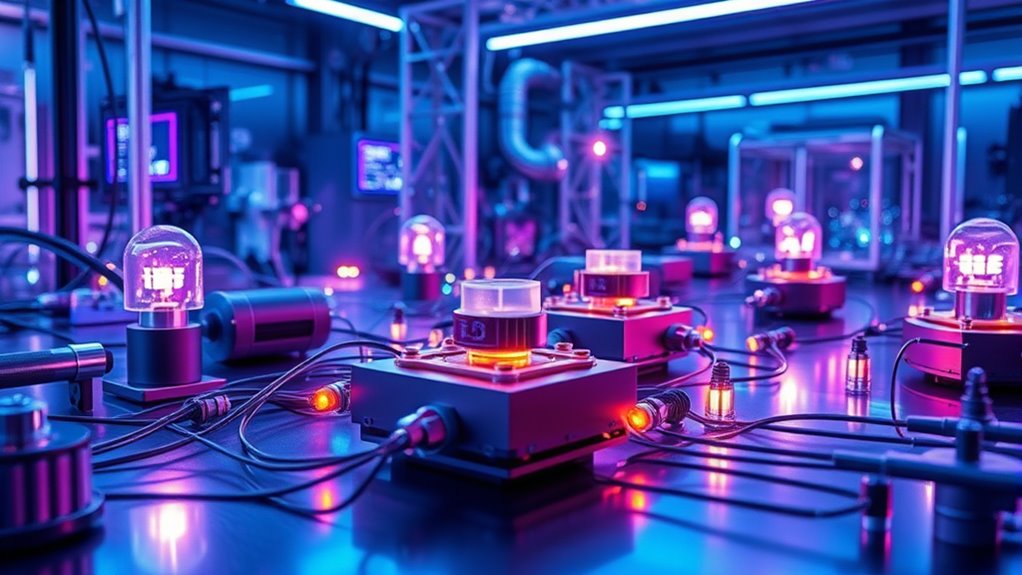Quantum gravity detectors could reveal phenomena that connect quantum mechanics and gravity, opening the door to new physics. By using ultra-sensitive measurement techniques and entangled particles, you might detect spacetime fluctuations or gravitational signals beyond current capabilities. Despite challenges like noise and high costs, advances in technology could make these discoveries possible. Stay with us to explore how these cutting-edge tools could revolutionize our understanding of the universe.
Key Takeaways
- Ultra-sensitive quantum detectors can identify subtle spacetime fluctuations indicating quantum gravity effects.
- Detecting entanglement disruptions or gravitational waves may reveal phenomena beyond current physics models.
- Advances in measurement precision can help unify gravity with quantum mechanics, unveiling new fundamental principles.
- Observing quantum gravitational signals could lead to groundbreaking insights into black holes and the early universe.
- Overcoming technical challenges in detector sensitivity may open pathways to discovering previously unknown physical laws.
The Quest for Detecting Quantum Gravity

Have you ever wondered how gravity works at the quantum level? Scientists are enthusiastic to uncover this mystery, and quantum entanglement plays a vital role in their efforts. By studying entangled particles, researchers hope to detect subtle effects of quantum gravity that could reveal new physics. One promising approach involves dark matter detection; since dark matter interacts weakly, quantum sensors might pick up tiny gravitational signals from it. These signals could help confirm theories that unify gravity with quantum mechanics. Your curiosity drives this quest, pushing scientists to develop innovative experiments. Although challenging, detecting quantum gravity could revolutionize our understanding of the universe’s fundamental forces. Every step forward brings us closer to understanding how gravity operates within the quantum domain. Recent advances in Kia Tuning demonstrate how precise modifications can improve performance, inspiring similar innovations in experimental physics.
Cutting-Edge Technologies in Quantum Measurement

Advances in quantum measurement technologies are opening new pathways to explore the universe’s deepest mysteries. You now have tools that leverage quantum entanglement, allowing measurements with unprecedented precision. By entangling particles, you can reduce noise and improve sensitivity in detecting faint signals, such as those from quantum gravity phenomena. However, measurement backaction remains a challenge; observing a quantum system inevitably disturbs it. Cutting-edge techniques minimize this effect, enabling more accurate readings without collapsing the quantum state prematurely. These innovations push the boundaries of what’s measurable, making it possible to detect subtle spacetime distortions or gravitational waves at quantum scales. As a result, you’re better equipped to probe phenomena that traditional instruments can’t reach, paving the way for breakthroughs in understanding the contrast ratio of spacetime.
How Ultra-Sensitive Detectors Work

Ultra-sensitive detectors operate by measuring extremely faint signals that are often buried in noise, requiring sophisticated techniques to distinguish genuine signals from background interference. To achieve this, you use quantum entanglement, which links particles so their states remain correlated even across distances, enhancing detection sensitivity. Detector calibration is vital; you fine-tune the system to ensure accurate measurements and reduce errors. By calibrating carefully, you can identify and minimize noise sources, making subtle signals more discernible. Quantum entanglement allows you to improve the precision of your measurements beyond classical limits. Additionally, integrating advanced data analysis techniques helps in filtering out residual noise and extracting meaningful signals. These combined techniques enable you to detect phenomena as weak as quantum gravity effects, pushing the boundaries of measurement science and opening new possibilities for understanding the universe’s fundamental nature.
Potential Signatures of Quantum Gravity

You might observe spacetime fluctuations, which could reveal quantum gravity effects. Anomalous particle dispersion patterns may also point to new physics beyond current theories. Additionally, unique gravitational wave signatures could serve as direct evidence of quantum phenomena in spacetime. Incorporating mindfulness techniques into observational strategies could enhance focus and accuracy in detecting these subtle signals.
Spacetime Fluctuations Detection
Detecting spacetime fluctuations is a promising approach to uncover signatures of quantum gravity, as these tiny variations could reveal how spacetime behaves at the smallest scales. When spacetime fluctuates, it can affect phenomena like quantum entanglement, potentially disrupting or modifying entangled states. These fluctuations also influence spacetime topology, causing small, transient changes that might be measurable with sensitive detectors. By observing how quantum entanglement patterns shift or degrade, you can gather clues about the underlying quantum structure of spacetime. Such measurements could help distinguish between different theories of quantum gravity and shed light on the fundamental fabric of the universe at Planck-scale dimensions. Embracing such measurement techniques can deepen our understanding of the quantum nature of spacetime. This approach opens a window into the elusive quantum domain of spacetime.
Anomalous Particle Dispersion
Spacetime fluctuations can influence how particles propagate through the universe, leading to what scientists call anomalous dispersion. This effect may alter neutrino oscillations, causing subtle shifts in their energy and flavor transitions that deviate from standard models. Such anomalies could signal quantum gravity effects influencing particle behavior over vast distances. Additionally, dark matter interactions might exhibit unexpected dispersion patterns, hinting at underlying quantum spacetime structures. Detecting these minuscule deviations requires highly sensitive instruments, but they offer a promising way to observe potential quantum gravity signatures. By examining how particles like neutrinos and dark matter respond differently than predicted, you could uncover evidence of the granular fabric of spacetime, opening a new window into physics beyond current theories. Understanding quantum gravity is essential to interpret these potential signals and differentiate them from other astrophysical phenomena.
Gravitational Wave Signatures
Could gravitational waves hold clues to quantum gravity effects? Yes, they might reveal subtle signatures related to quantum entanglement and holographic principles. Quantum entanglement could influence the structure of spacetime at microscopic scales, affecting the propagation of gravitational waves. These effects might produce tiny deviations or distinctive patterns detectable by advanced detectors. The holographic principle suggests that information within a volume of space is encoded on its boundary, implying that gravitational waves could carry imprints of this information encoding. By analyzing gravitational wave signals from cosmic events, you could uncover evidence of quantum gravity phenomena. Such signatures might manifest as anomalies or specific frequency modulations, opening a window into the fundamental nature of spacetime and revealing new physics beyond classical descriptions.
Challenges and Limitations of Current Approaches

You’ll find that current quantum gravity detectors face significant technical sensitivity limits, making it hard to detect faint signals. Noise and interference from environmental factors further complicate measurements, reducing accuracy. Additionally, the scale and cost of building and maintaining these advanced detectors pose major practical challenges.
Technical Sensitivity Limits
What limits the sensitivity of current quantum gravity detectors? Primarily, detector calibration plays a pivotal role. Precise calibration ensures measurements are accurate, but even small errors can obscure subtle quantum effects. Additionally, quantum entanglement, indispensable for enhancing detector sensitivity, faces practical challenges. Maintaining stable entanglement over large scales or long durations is difficult, reducing the potential for detecting faint signals. These limitations mean current setups struggle to reach the sensitivity needed to observe quantum gravity phenomena directly. Environmental factors, such as temperature fluctuations and electromagnetic interference, further hamper performance. Overcoming these technical hurdles requires advancements in calibration techniques, better control of entanglement, and isolation methods, all of which are essential to push the boundaries of what quantum gravity detectors can achieve. Moreover, the trustworthiness of measurement tools is crucial for ensuring the reliability of experimental results and advancing the field.
Noise and Interference Challenges
While technical calibration and entanglement stability limit the sensitivity of current quantum gravity detectors, noise and interference pose equally significant challenges. Background noise from environmental vibrations, thermal fluctuations, and electromagnetic signals can drown out the faint signals you’re trying to detect. Signal interference from nearby equipment or cosmic sources further complicates measurements, making it difficult to isolate genuine quantum signals. These issues reduce the reliability of data and increase false positives. To better understand these challenges, consider the table below:
| Source of Noise | Impact |
|---|---|
| Environmental vibrations | Disrupts delicate measurements |
| Thermal fluctuations | Alters quantum states |
| Electromagnetic signals | Introduces false signals |
| Cosmic radiation | Adds background noise |
| Nearby equipment | Causes signal interference |
Additionally, home decoration inspiration can play a role in creating controlled environments that minimize some of these noise sources, improving measurement fidelity.
Scale and Cost Constraints
Current quantum gravity detectors face significant scale and cost limitations that hinder widespread deployment and development. Scaling challenges arise because these detectors require massive, highly sensitive equipment, making them expensive and complex to build and maintain. The large scale needed for effective measurements increases manufacturing costs and logistical hurdles. Funding hurdles also play a major role, as the high costs limit research budgets and slow progress. Without sufficient financial support, advancing the technology becomes difficult, restricting experimental possibilities. These constraints mean that only a few specialized labs can afford to develop and operate such detectors. As a result, it’s challenging to conduct large-scale or long-term experiments essential for groundbreaking discoveries in quantum gravity. Overcoming these barriers is critical for expanding the reach and impact of these advanced detection systems. Additionally, technological innovation is necessary to develop more cost-effective and scalable solutions that can democratize access to quantum gravity research.
Implications for Physics and Our Understanding of Reality

How might the ability to detect quantum gravity effects transform our understanding of the universe? You could unveil answers to fundamental questions, reshaping physics and challenging existing paradigms. These discoveries might influence philosophical implications, prompting metaphysical debates about reality’s nature. Consider the following possibilities:
| Impact | Description | Potential Outcome |
|---|---|---|
| Redefining Reality | New physics could alter our concept of spacetime. | Shift in scientific worldview. |
| Unity of Forces | Quantum gravity may unify gravity with other forces. | A more complete theory of everything. |
| Philosophical Shift | Challenges existing metaphysical assumptions. | New debates on existence and consciousness. |
| Technology Leap | Advances in detection could lead to new tech. | Breakthroughs in quantum computing. |
| Understanding Cosmos | Insights into black holes and the early universe. | Deeper grasp of cosmic origins. |
| Enhanced Detection Capabilities | Improved quantum detectors could enable more precise measurements of gravitational phenomena. | Broader experimental validation and technological innovation. |
Frequently Asked Questions
Can Quantum Gravity Detectors Be Used for Practical Everyday Applications?
You might wonder if quantum gravity detectors can be used for everyday purposes. While their primary goal is scientific research, technological integration could eventually make them more practical. However, their current complexity and size limit everyday usability. As technology advances, we could see more compact, user-friendly versions that might serve specialized roles, but widespread practical applications are still a long way off. For now, they remain mainly tools for cutting-edge physics exploration.
How Soon Might We Expect Definitive Evidence of Quantum Gravity?
You wonder when we’ll get definitive evidence of quantum gravity, but it’s like waiting for a rare comet—uncertain and distant. Experimental timelines depend on advances in detector sensitivity, which are progressing steadily but face technical challenges. While some scientists hope for breakthroughs within the next decade, others believe it could take much longer. So, it’s a waiting game, with progress measured in years, not months, until we decipher these cosmic mysteries.
Are There Alternative Theories to Quantum Gravity That These Detectors Could Test?
You might wonder if these detectors can test alternative theories beyond quantum gravity. Yes, they could explore models like string theory or loop quantum gravity, which propose different ways spacetime behaves at tiny scales. These detection methods offer new opportunities to gather evidence supporting or challenging such ideas. By analyzing the signals, you may uncover clues that reveal whether these alternative theories hold up against experimental data.
What Are the Potential Risks or Unintended Consequences of Developing These Detectors?
Imagine building a telescope so powerful it risks exposing hidden secrets of the universe. Developing quantum gravity detectors could lead to ethical dilemmas, like privacy concerns if misused. They might also have environmental impacts during manufacturing or operation. You should consider these risks, as unintended consequences could include disrupting natural systems or sparking misuse, highlighting the need for careful regulation and ethical guidelines in advancing such groundbreaking technology.
Could Quantum Gravity Insights Influence Other Fields Like Cosmology or Particle Physics?
You might wonder how insights into quantum gravity could impact other fields. These discoveries could have significant cosmological implications, helping you better understand the universe’s origins and structure. In particle physics, they might reveal new particles or forces, challenging current theories. By bridging these areas, you could unseal a deeper understanding of fundamental laws, pushing the boundaries of science and opening new avenues for research and technological advancement.
Conclusion
Imagine holding a tiny, delicate compass that points to unknown worlds — that’s what quantum gravity detectors aim to do. With each breakthrough, you get closer to uncovering hidden aspects of reality, like discovering a secret door in a familiar room. Although challenges remain, these ultra-sensitive tools could open the universe’s deepest mysteries. Just as explorers once charted new lands, you’re on the brink of revealing the next frontier in physics.










